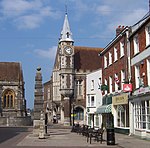Dinosaur Museum (Dorchester)
Dinosaur museumsDinosaur stubsEducation in Dorchester, DorsetGeology museums in EnglandMuseums in Dorchester, Dorset ... and 3 more
Natural history museums in EnglandUnited Kingdom museum stubsUse British English from February 2023

The Dinosaur Museum is a museum presenting dinosaurs in Dorchester, the county town of Dorset, in southern England. The Dinosaur Museum is the only museum in mainland Britain dedicated purely to dinosaurs. The museum is not far from the Jurassic Coast to the south, a World Heritage Site. The museum is based in Icen Way in central Dorchester. It features an outdoor model of a triceratops that was renovated in 2012. At Easter, the museum features a dinosaur Easter egg hunt.
Excerpt from the Wikipedia article Dinosaur Museum (Dorchester) (License: CC BY-SA 3.0, Authors, Images).Dinosaur Museum (Dorchester)
Icen Way,
Geographical coordinates (GPS) Address Phone number Website External links Nearby Places Show on map
Geographical coordinates (GPS)
| Latitude | Longitude |
|---|---|
| N 50.7149 ° | E -2.4341 ° |
Address
Dinosaur Museum
Icen Way
DT1 1EW
England, United Kingdom
Open on Google Maps










